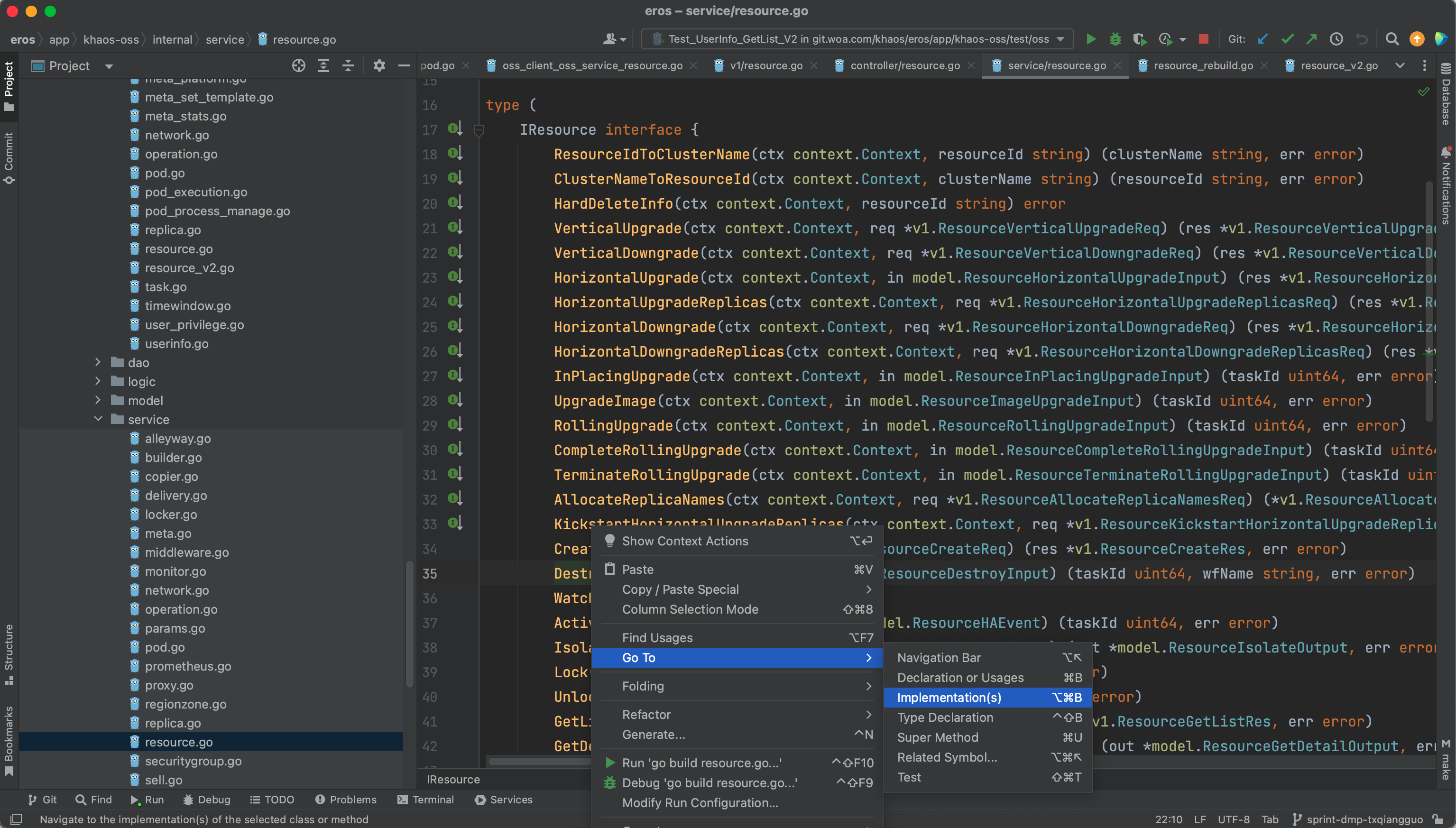This feature is an experimental feature. It is recommended for developers to focus on module division under logic, streamline inter-module relationship, avoid circular dependencies, and fully utilize the circular dependency detection feature of the Golang compiler to write higher quality project code.
This feature is available from version v2.1.
Introduction
Design Background
In business project practices, business logic encapsulation is often the most complex part. Meanwhile, dependencies between business modules are very complex and boundaries are vague, making it difficult to use the Golang package management form. Effectively managing the encapsulation part of business logic in a project is a challenge that every project developed with Golang is bound to encounter.
In a standard software design process, dependencies between modules first clarify API definitions, and then the implementation is done through code during the software development process. However, in most high-paced internet engineering, there isn't a rigorous software design process, and the quality level of developers varies. Most developers first focus on how to implement the functional logic corresponding to the requirements scenario to maximize development efficiency.
Design Objectives
- Provide a code management method that can directly generate module API definitions and module registration code through specific module implementation.
- Simplify the implementation of separating business logic and interfaces, reduce the repetitive operation of module methods and API definitions, and enhance module transparency and ease of invocation between modules.
Design Implementation
- Add a
logiccategory directory, migrate all business logic code to thelogiccategory directory, and manage business modules in the form of package management. - Dependencies between business modules are decoupled through interfaces, and the original
servicecategory is adjusted to an interface directory. Each business module will maintain its own, being more flexible. - Based on certain coding specifications,
serviceAPI definition code can be generated from thelogicbusiness logic code. It also allows for manual maintenance of this part of theserviceinterface.
Things to Note
Again, implementing service interfaces through logic is not a standardized code management practice but provides another optional, convenient code management method. This management method has both advantages and disadvantages. The advantage is that it is more convenient for business module interface auto-generation in microservice scenarios; the disadvantage is that it cannot recognize syntax inheritance relationships, cannot generate parent nested type methods, and disregards the Golang compile-time detection of circular dependencies.
The framework's project management also supports the standard interface code management approach, i.e., defining service interfaces first, then coding logic for concrete implementation. Note that the service source code must not contain top comment information used by the tool (the tool uses this comment to determine if the file can be overwritten 😈). Many colleagues kept the comment at the top when copying and pasting files, rendering manual interface file maintenance invalid. See screenshot annotation:
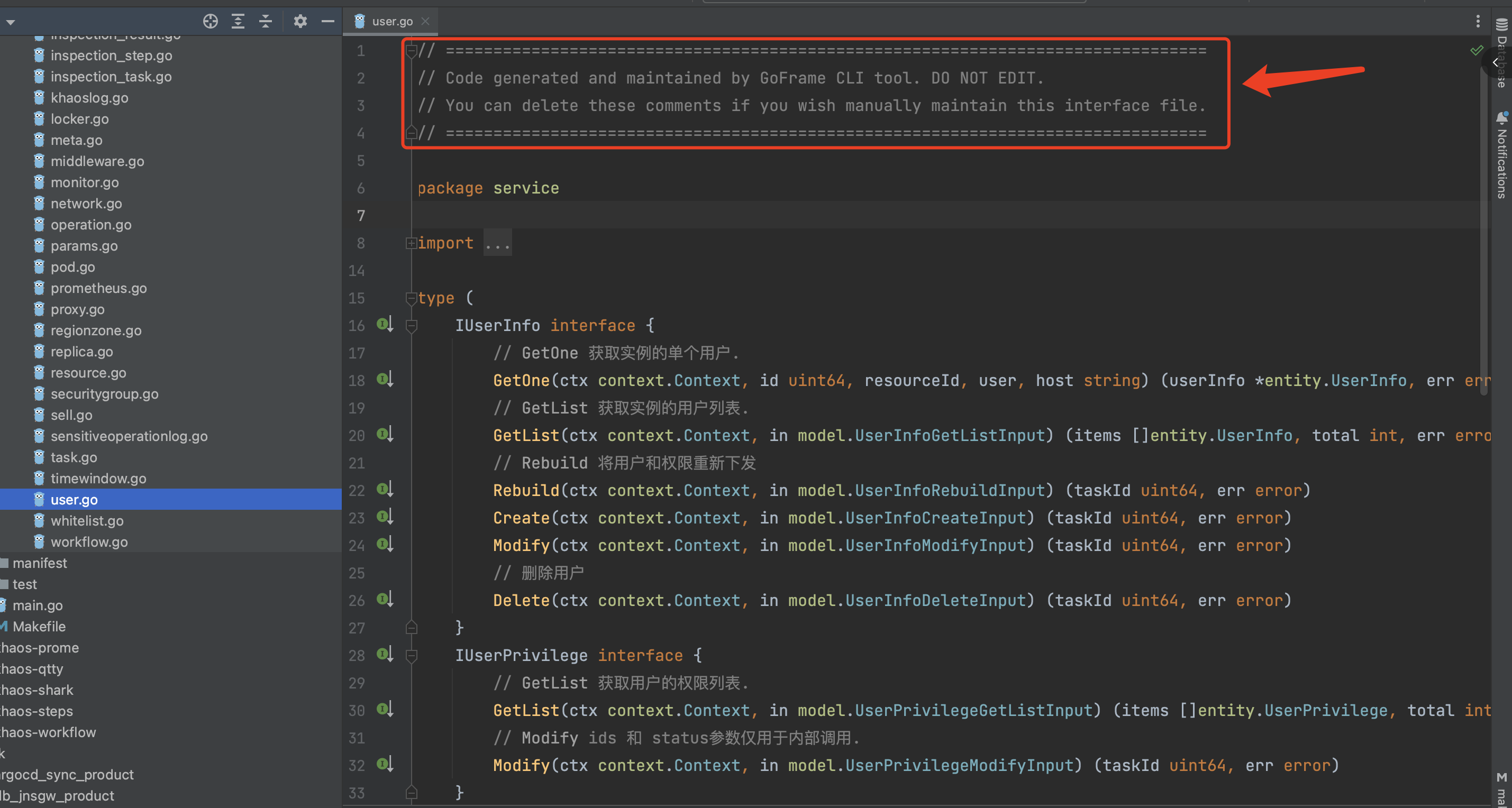
Command Usage
This command analyzes the code under the given logic business logic module directory to automatically generate service directory interface code.
Please note:
- Since this command generates
serviceinterfaces based on business modules, it only parsesgocode files in secondary directories and does not recursively analyze code files indefinitely. Takinglogicdirectory as an example, this command only parseslogic/xxx/*.gofiles. Thus, thelogiclayer code structure needs to meet specific specifications. - Struct names defined in different business modules may overlap when generating
serviceinterface names, so it is necessary to ensure that names do not conflict when designing business modules.
For a sample project using this command, please refer to: https://github.com/gogf/gf-demo-user
Manual Mode
If executing the command manually, simply execute gf gen service in the project root directory.
$ gf gen service -h
USAGE
gf gen service [OPTION]
OPTION
-s, --srcFolder source folder path to be parsed. default: internal/logic
-d, --dstFolder destination folder path storing automatically generated go files. default: internal/service
-f, --dstFileNameCase destination file name storing automatically generated go files, cases are as follows:
| Case | Example |
|---------------- |--------------------|
| Lower | anykindofstring |
| Camel | AnyKindOfString |
| CamelLower | anyKindOfString |
| Snake | any_kind_of_string | default
| SnakeScreaming | ANY_KIND_OF_STRING |
| SnakeFirstUpper | rgb_code_md5 |
| Kebab | any-kind-of-string |
| KebabScreaming | ANY-KIND-OF-STRING |
-w, --watchFile used in file watcher, it re-generates all service go files only if given file is under
srcFolder
-a, --stPattern regular expression matching struct name for generating service. default: ^s([A-Z]\w+)$
-p, --packages produce go files only for given source packages
-i, --importPrefix custom import prefix to calculate import path for generated importing go file of logic
-l, --clear delete all generated go files that are not used any further
-h, --help more information about this command
EXAMPLE
gf gen service
gf gen service -f Snake
If using the framework's recommended project scaffold and the make tool is installed on the system, the make service shortcut command can also be used.
Parameter Description:
| Name | Required | Default | Meaning |
|---|---|---|---|
srcFolder | Yes | internal/logic | Points to the logic code directory address |
dstFolder | Yes | internal/service | Points to the directory where the generated interface files are stored |
dstFileNameCase | No | Snake | The format of the generated filename |
stPattern | No | s([A-A]\w+) | Use regular expression to specify the business module struct definition format for easy parsing of business API definition names. Under the default regex, all structs starting with lowercase s followed by uppercase letters will be treated as business module interface names. For example: |
| Logic Struct Name | Service Interface Name |
|---|---|
sUser | User |
sMetaData | MetaData |
watchFile | |
packages | |
importPrefix | |
overwrite | |
clear |
Automatic Mode
Goland/Idea
If you are using GolandIDE, you can use the configuration file we provide: watchers.xml to automatically monitor code file modifications and automatically generate interface files. Usage is shown in the picture below:
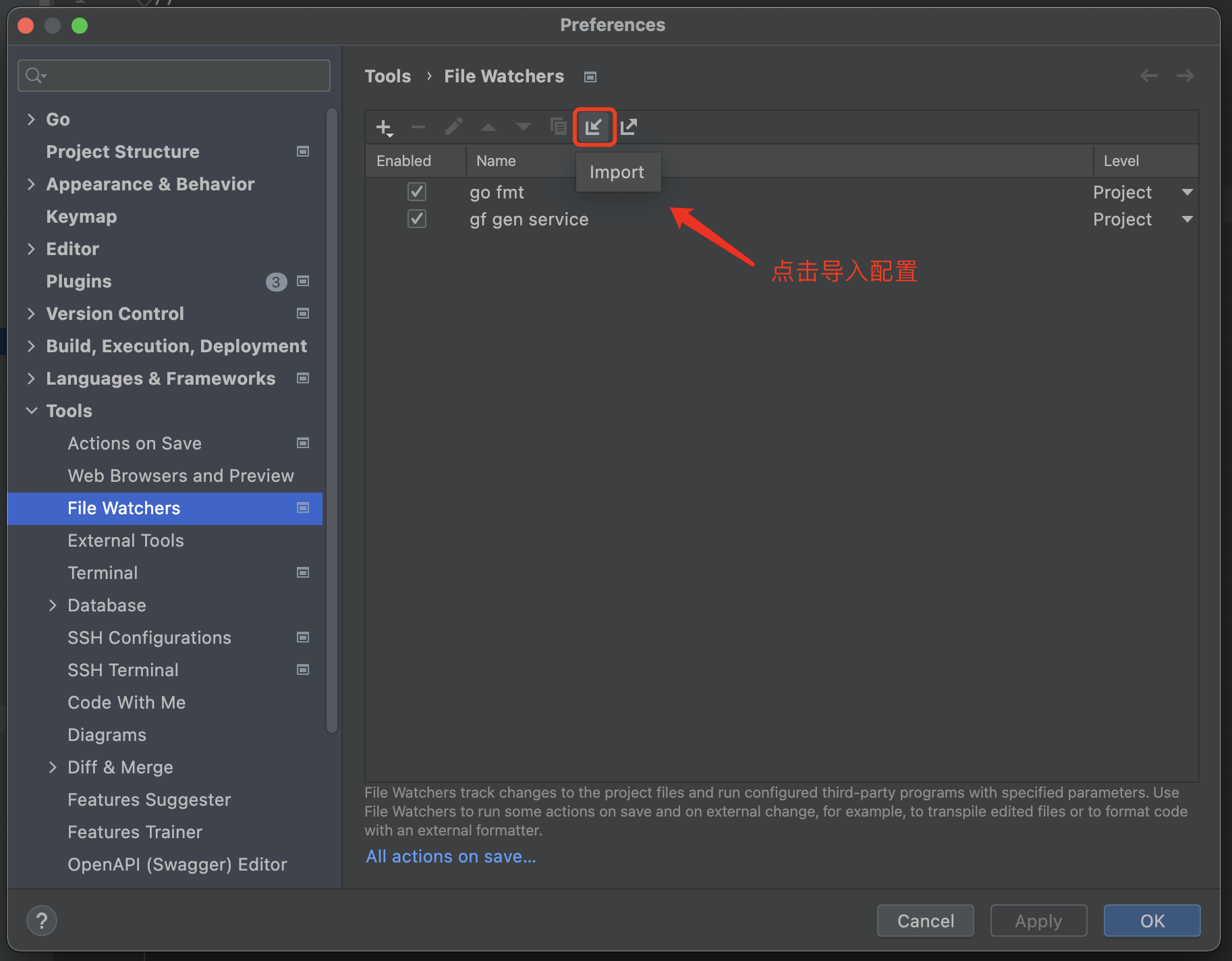
Visual Studio Code
If you are using Visual Studio Code, you can install the plugin RunOnSave and then configure the plugin:
"emeraldwalk.runonsave": {
"commands": [
{
"match": ".*logic.*go",
"isAsync": true,
"cmd": "gf gen service"
}
]
}
Specific Usage: Step by Step
Step1: Include the Configuration We Provide
We recommend using the configuration file: watchers.xml when using Goland IDE.
Step2: Write Your Business Logic Code

Step3: Generate Interface and Service Registration Files
If you have done the configuration in Step1, you can ignore this step. Because when you write code, service will generate the API definition file at the same time.
Otherwise, every time you finish developing/updating the logic business module, you need to manually execute the gf gen service command.
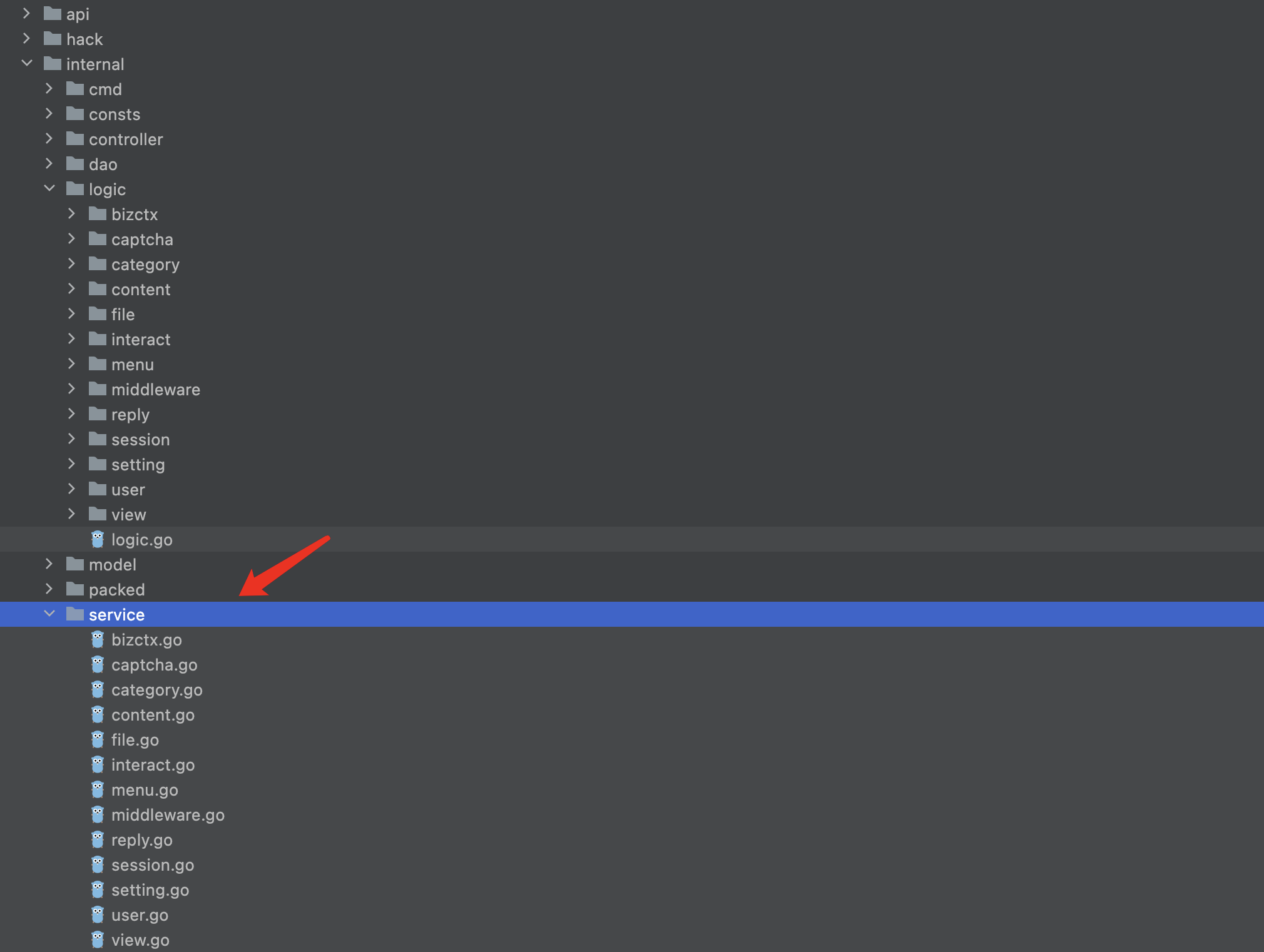
Step4: Pay Attention to the Service Implementation Injection Part (Only Once)
Only after the interface files are generated can you add the specific implementation injection of the interface in each business module. This method is added once per business module.
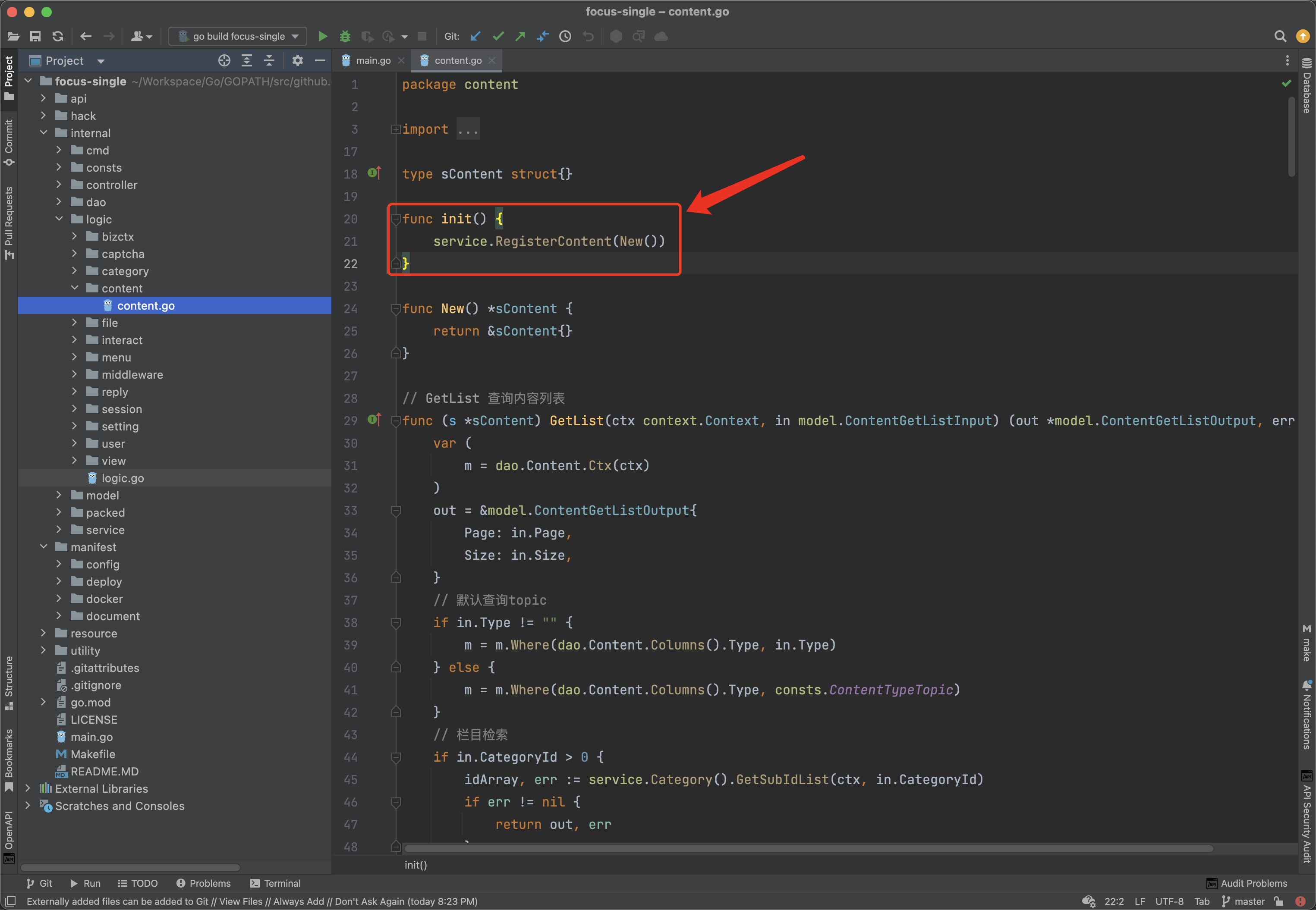
Step5: Reference Interface Implementation Registration in the Startup File (Only Once)
It can be noticed that besides generating interface files, this command also generates an interface implementation registration file. This file is used to register the specific implementation of the interface during program startup.
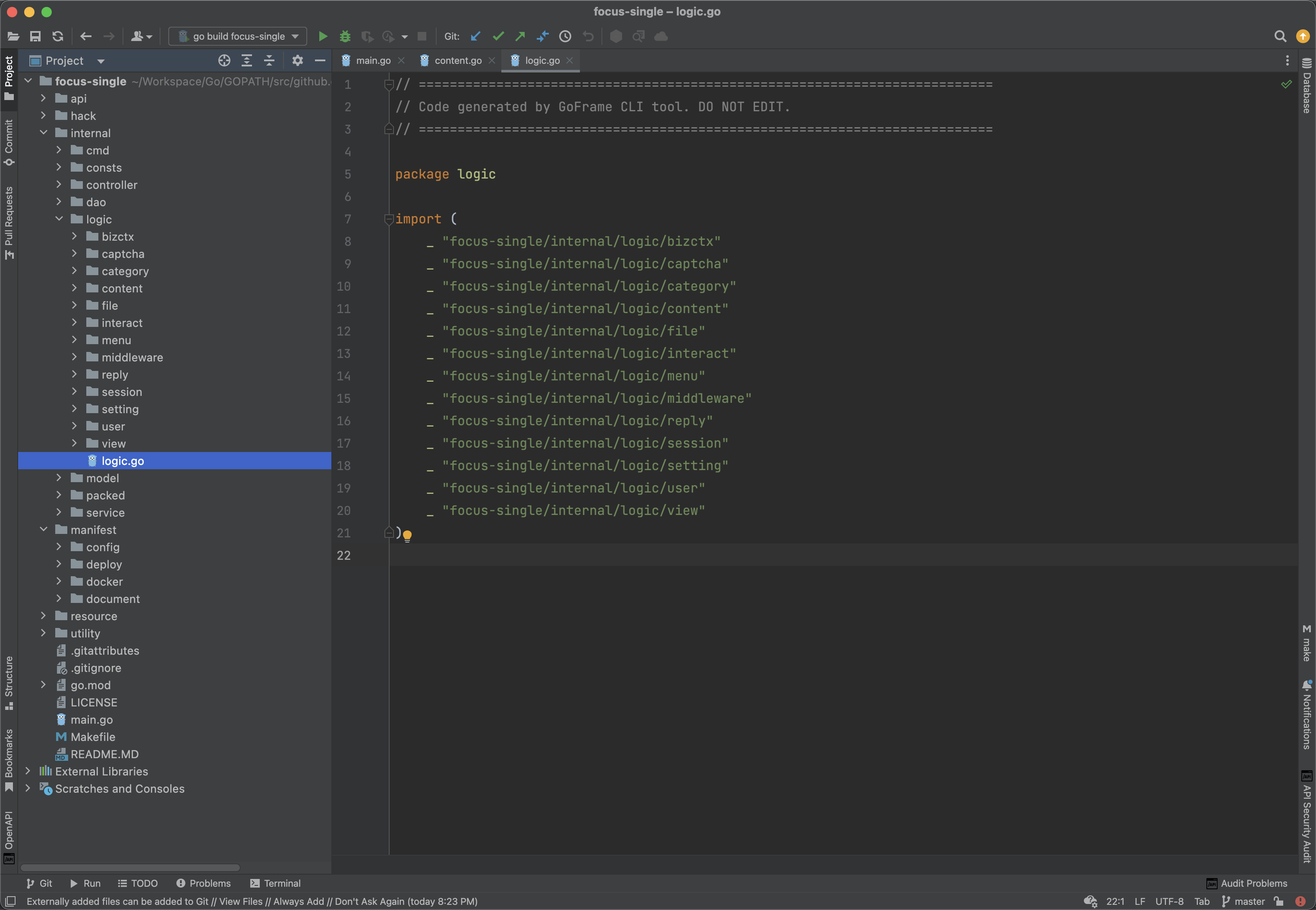
The introduction of this file needs to be at the top of the main package import, and note the order of import, placing it at the top with a blank line behind. If the packed package is also imported, place it after the packed package. Like this:
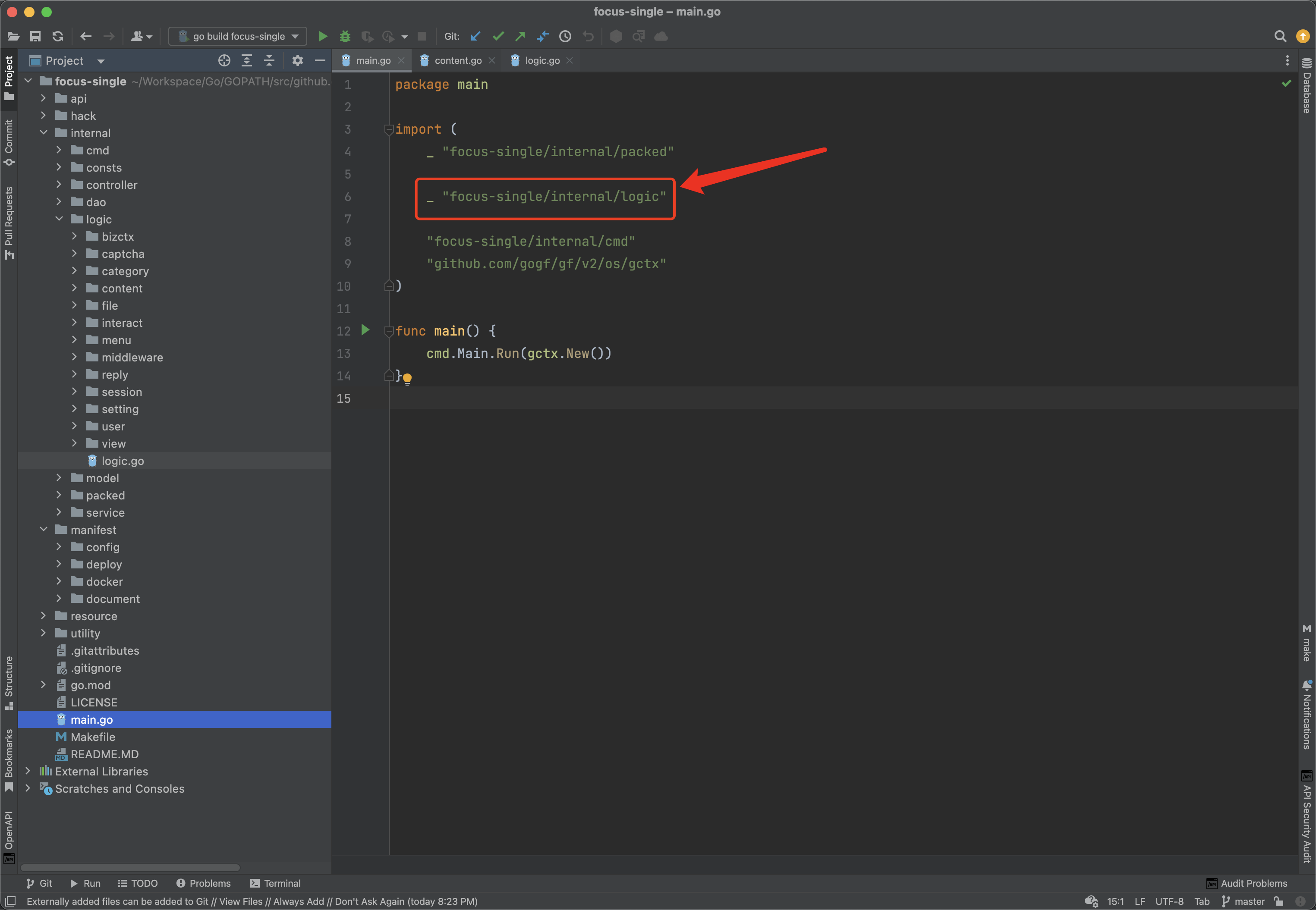
Step6: Start & Enjoy
Simply start main.go.
Common Issues FAQ
When a structure in logic has nested types, methods for the nested types cannot be automatically generated
In such cases, it is recommended to manually maintain the service API definitions and not use the automatic generation tool. The manually maintained API definition files will not be overwritten by the tool, and both manual and automatic methods can be used together.
Quickly Locate Specific Implementations of Interfaces
After adopting interface-based decoupling for project business modules, the experience is fantastic! But if I want to quickly find the specific implementations of specified interfaces during development and debugging, it's a bit challenging. Any guiding thoughts?
> Here, I recommend using Goland IDE, which has an excellent interface implementation locating feature, as shown in the figure. After finding the API definition, click the small icon on the left to quickly locate the specific implementations. If Goland doesn't show the small icon, try upgrading to the latest version of Goland.

Alternatively, if there is no small icon on the left, you can right-click to select Go To → Implementation(s).
